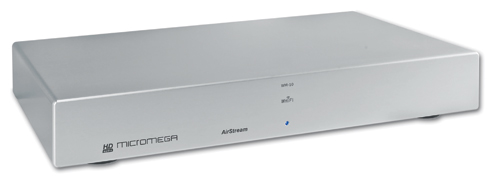New Tech 2010: Audio Gear

Most of the big recent news in audio has involved a seemingly endless stream of new surround sound formats. First came uncompressed multichannel Dolby TrueHD and DTS-HD Master Audio soundtracks on Blu-ray Disc. Then last year the listening experience reached new heights as Dolby ProLogic IIz and Audyssey DSX processing brought the vertical axis of our home theaters into play. Now it looks like the surround folks are finally taking a breather, which means we can swing the spotlight back over to stereo, where some big changes have been taking place.

CUT THE CHORD
Chord Electronics' Cyan Click integrated amp connects to a cellphone, iPhone/iPod touch, or computer via Bluetooth A2DP. Along with its wireless hookup option, the Cyan Click offers stereo analog and optical/coaxial digital jacks plus a USB port. Both 50- and 100-watt-per-channel versions are available.
Audiophiles are finally starting to embrace the concept of using computers to deliver music. Not long ago, the high cost of digital storage meant that audio files had to be compressed. But with hard drives now selling for under a buck per gigabyte, even uncompressed high-rez recordings can be stored inexpensively.
A FORK IN THE ROAD
At the last couple of audio shows I've attended, including the high-performance audio section at the recent 2010 Consumer Electronics Show, I'd noticed a clear trend of companies using means other than silver discs to provide music for demonstrations. That's not surprising, really, given both the technical straitjacket that the CD has been locked in for some 30 years and the dual knockout suffered by SACD and DVD-Audio following their format battle (a competition that, let's face it, went largely unnoticed by the general public).
Since then, it has been fascinating to watch audiophiles divide over what technology should take the CD's place. Some have hitched their wagons to digital files in one form or another, while others continue to back the ongoing resurgence of the good old vinyl LP. In truth, each approach can deliver impressive performance, although I imagine it will be the rare audiophile who chooses to follow both of these highly divergent paths.

Micromega's AirStream WM-10 DAC has no physical inputs at all, relying instead on Wi-Fi to get its data stream. Audiophile goodness packed inside the WM-10 includes 24-bit/192 kHz DACs, jitter-reducing re-clocking circuits, and a noise-filtering power transformer.
BITS AND STREAMS
It's taken a while, but many audiophiles are finally starting to embrace the concept of using computer technology - in the form of PCs/Macs or standalone hard-disk media servers - to deliver high-quality music. Not too long ago, the high cost of digital storage meant that audio files were often compressed to save disc space, even though their resulting sound quality ended up compromised. But with computer hard drives now selling for under a buck per gigabyte, even uncompressed high-resolution recordings can be stored inexpensively.
Audio quality is usually a pretty low priority for computer manufacturers, so it's important to find a way to use audio gear to squeeze the maximum possible performance from digital files when using a PC or Mac as a source device. Many of the latest high-end digital-to-analog converters are equipped with a computer-friendly USB or FireWire input, which simplifies the process of getting your computer and audio gear to work together. Not all USB inputs are created equal, however. There's been a lot of recent buzz in the computer audiophile community surrounding so-called asynchronous USB, which allows the DAC to control the timing of the incoming data stream, thereby reducing sound-degrading jitter. Asynchronous USB can be found on gear like the Wavelength Audio Proton DAC ($900) and the Resolution Audio Cantata Music Center ($6,000), as well as in products from Ayre and MBL.

The Olive + Thiel HD Music System combines Olive's 4HD highrez music server with Thiel Audio's IP-based SCS4D powered speakers. The 4HD, which stores 6,000 CDs in uncompressed format, uses Ethernet cables to connect to up to four separate pairs of SCS4D speakers.
Digital circuits are notorious for creating electrical noise that can affect the performance of delicate analog circuits, so some DACs now totally sever any electrical connection to your computer, relying instead on a wireless link. Both the 50- and 100-watt-per-channel version of Chord Electronics' Cyan Click integrated amp ($7,500 and $8,500, respectively) can connect to your cellphone or any other compatible device via the A2DP Bluetooth profile. Micromega's AirStream WM-10 DAC ($1,595), meanwhile, has no physical inputs at all, relying instead on Wi-Fi to get its data stream. This means you can use the computer in your home office to wirelessly send signals to a WM-10 in your living room A/V system without having to worry about USB's maximum 15-foot cable length.
If you use a computer as your source, you're also going to need some kind of music- management software to sort through and play files. Many people use the ubiquitous Apple iTunes, but there are alternatives geared more toward the audiophile user, such as MediaMonkey and the Sonic Studio Amarra iTunes plug-in. Unlike iTunes, which comes pre-configured for casual users looking to stuff as many tunes as possible onto an iPod, these alternatives make it easier to rip and play back your files with maximum fidelity. MediaMonkey (mediamonkey.com) is a Windows program that can handle many of the popular lossless compression algorithms not covered by iTunes like OGG/Vorbis and FLAC. And for Mac users, Amarra (sonicstudio. com/amarra) bypasses the computer's CoreAudio processor to automatically deliver bit-perfect output with files at any resolution. In addition to ripping your own CDs using lossless or no compression, you can find high-rez downloads to augment your collection at online music stores like hdtracks.com. (Quality-conscious listeners should make a point of skipping Apple's iTunes store with its lossy AAC files.)
- Log in or register to post comments



































































